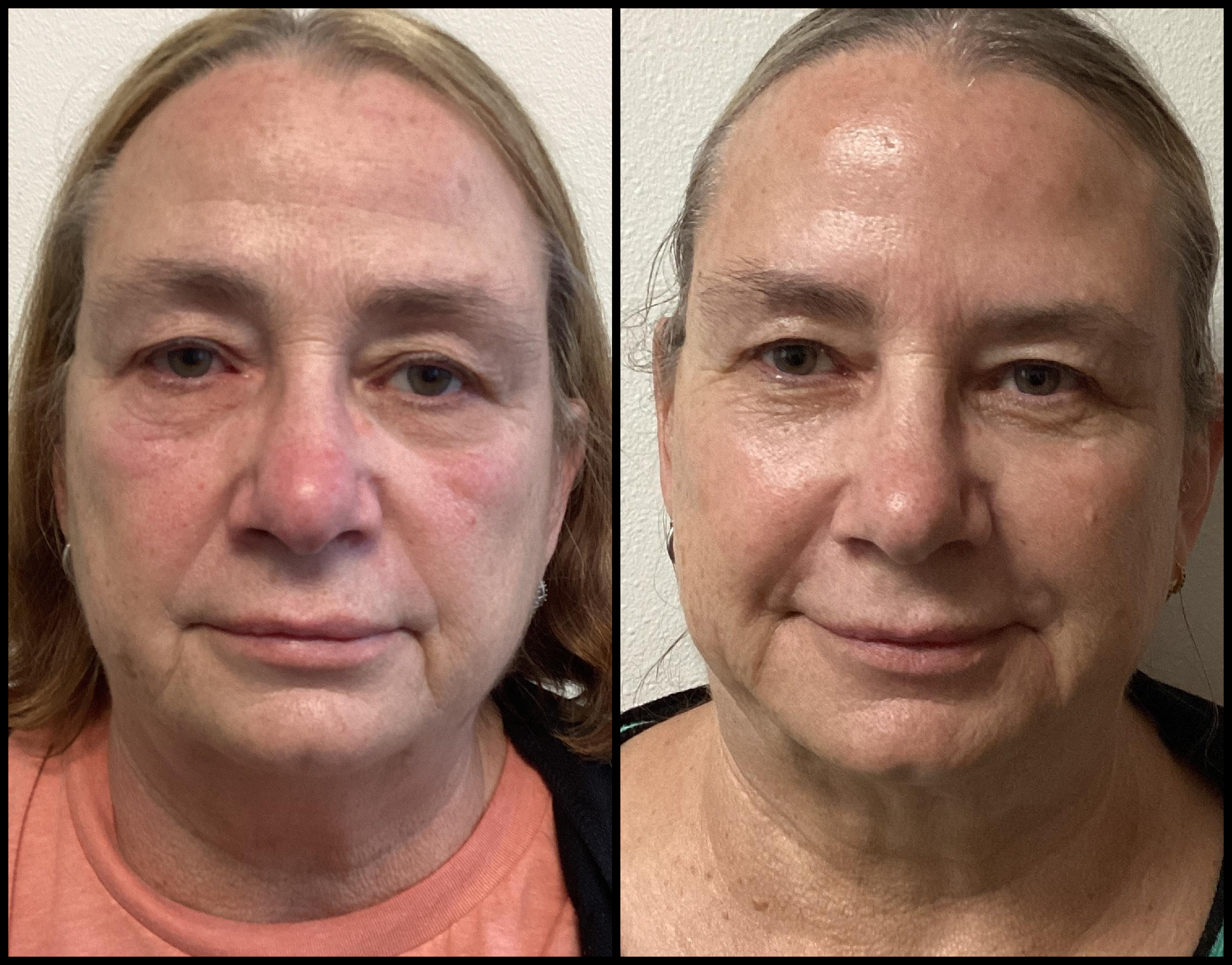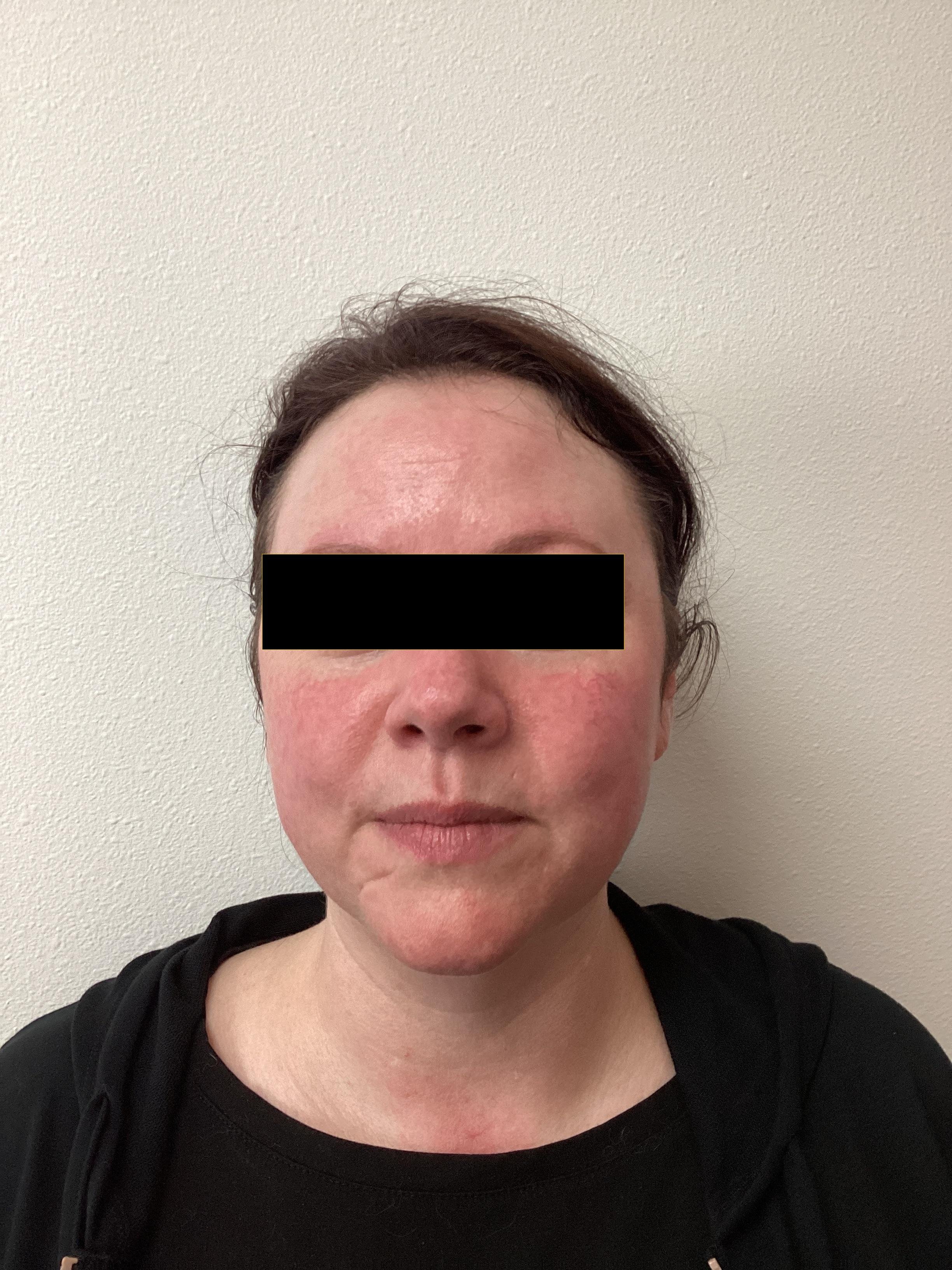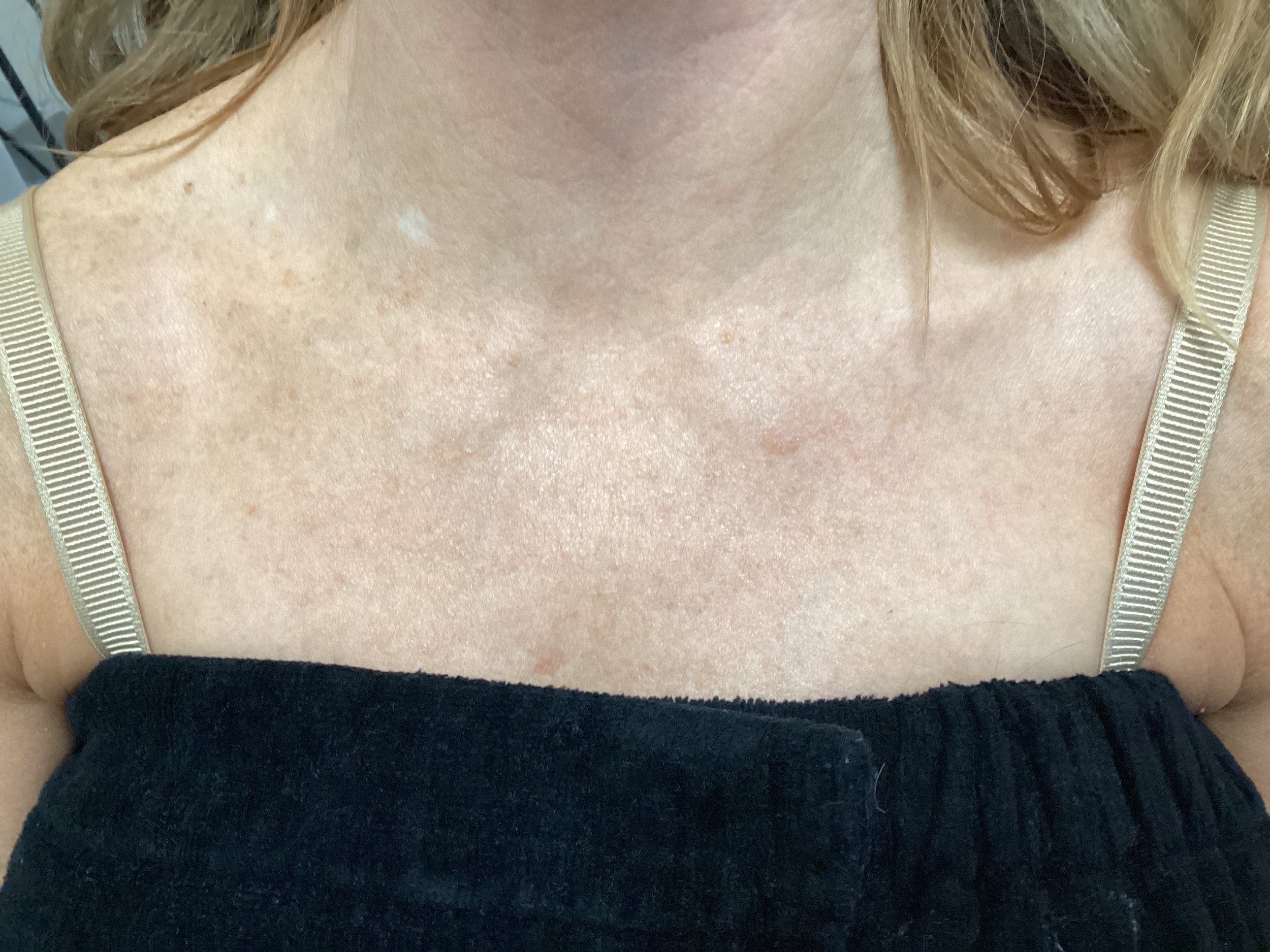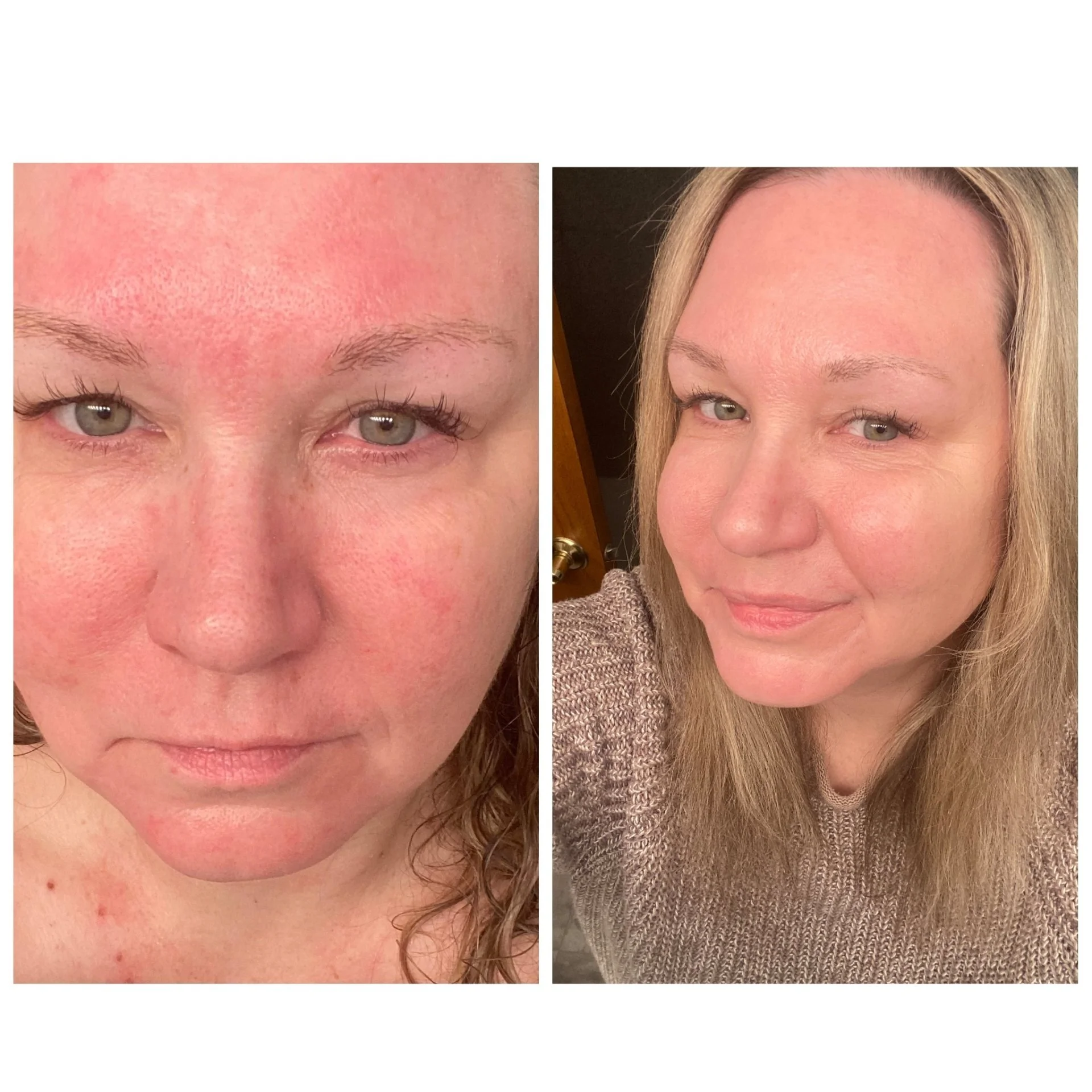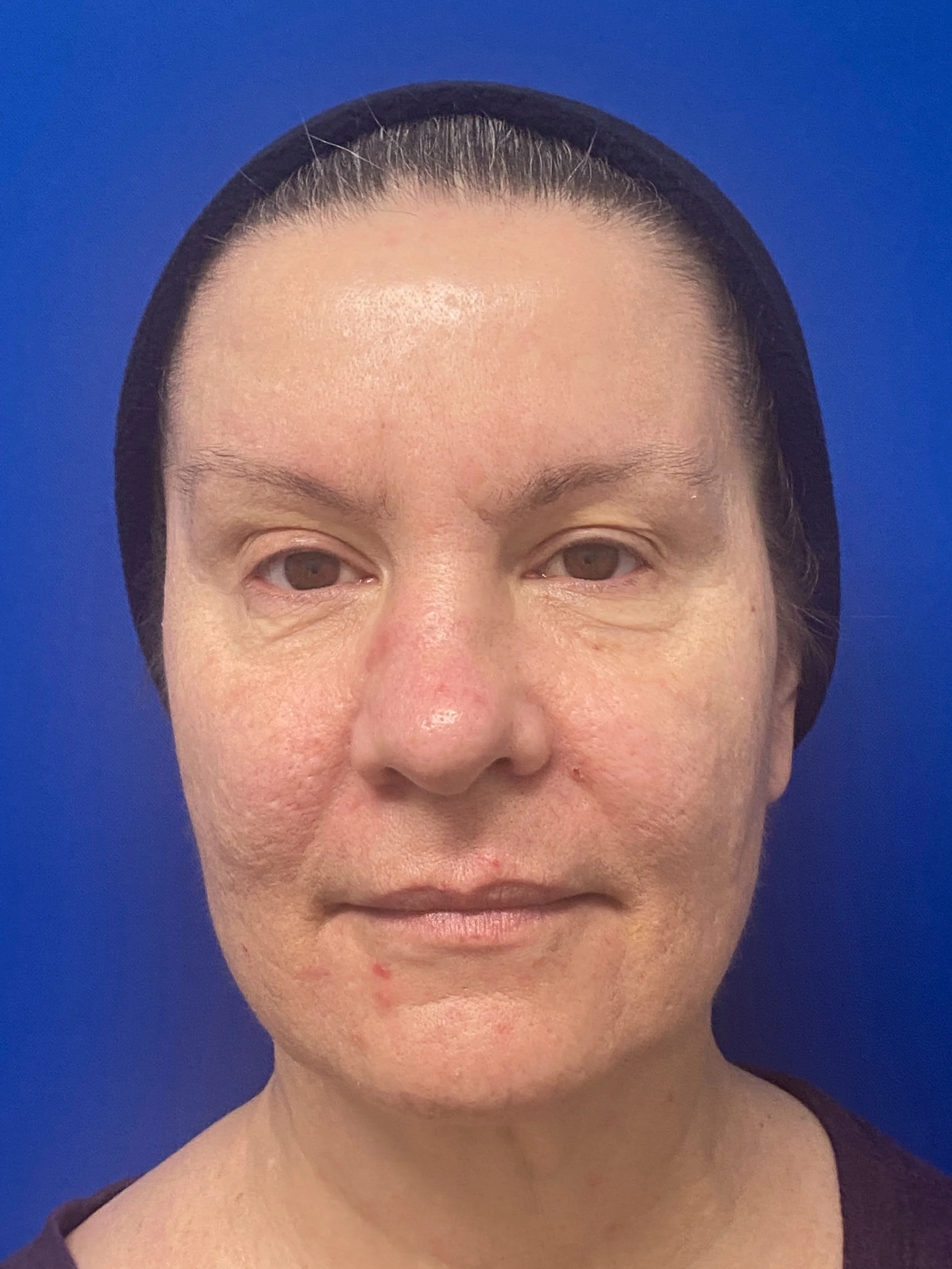Laser Hair Removal
Laser Hair Removal has become one of the most popular Cosmetic Procedures performed in the United States. It is a popular alternative to shaving and waxing, especially for those looking to save time. Learn more about Laser Hair Removal and see if you are a good candidate.
-
Laser hair removal is a noninvasive technique that uses highly concentrated light to penetrate hair follicles. The laser light is absorbed by the pigment in the hair shaft in the follicle-generating heat which damages the follicle to inhibit future hair growth. Therefore, plucking hair before treatment reduces the efficacy of the laser treatment as the target is absent.
Because laser hair reduction only affects actively growing hair follicles, it may take several laser hair removal treatments to provide significant hair reduction. Additionally, while laser hair removal effectively slows hair growth, it doesn’t guarantee permanent hair removal. Periodic maintenance treatments may be needed.
-
Although laser hair removal reduces the number of unwanted hairs in a given area, it doesn’t get rid of them completely. When the hair grows back, they will be finer, lighter, and fewer in number. Most people require between four and six sessions, and occasional maintenance may be required.
Laser hair removal uses laser beams to heat up and damage the hair follicles, which temporarily halts hair production.
-
Most commonly, laser hair removal is used to treat the face, body, legs, armpits and pubic area.
-
Our qualified master estheticians and nurses perform the laser hair removal procedure, or may delegate this to a nurse or other licensed provider. A beam of highly focused light is absorbed by hair in disabling unwanted hair follicles. There is some mild discomfort that last a few seconds. People with white or gray hair may not have enough pigment target to be a candidate for laser hair removal. Because hair grows in cycles, it typically takes three to four laser hair removal treatments to provide significant hair reduction.
-
Hair follicles hit by the laser during the treatment can take days to weeks to fully shed. Hairs do not fall out immediately and the shedding process may sometimes look like continued hair growth. Results vary significantly between people, which may be due to a variety of factors such as hair thickness, density or location.
Although laser hair reduction effectively delays hair growth for months to years, it usually does not result in permanent hair removal. However, compared to shaving and waxing, it offers a more permanent solution. Multiple sessions, usually 4-10 and spaced 4-6 weeks apart, are needed to target the various stages in the hair growth cycle. Following these sessions, a few maintenance sessions a year may also be needed for longer-term results.
IPL Photo Facial
Photorejuvenation, PhotoFacial, FotoFacial uses Intense Pulsed Light (IPL) in a breakthrough cosmetic medical skin treatment to correct the signs of photoaging (sun spots), as well as birthmarks, broken capillaries, benign brown pigments, redness or Rosacea, mottled pigmentation, port wine stains and other skin imperfections. It is safe for all ages, and a non-invasive solution that can be customized to your skin type to treat your specific pigmentation problem. Skin rejuvenation can be achieved on the face, as well as on the hands, neck, chest and arms.
-
Photorejuvenation, PhotoFacial, FotoFacial uses Intense Pulsed Light (IPL) in a breakthrough cosmetic medical skin treatment to correct the signs of photoaging (sun spots), as well as birthmarks, broken capillaries, benign brown pigments, redness or Rosacea, mottled pigmentation, port wine stains and other skin imperfections. It is safe for all ages, and a non-invasive solution that can be customized to your skin type to treat your specific pigmentation problem. Skin rejuvenation can be achieved on the face, as well as on the hands, neck, chest and arms.
-
Two weeks prior to your photorejuvenation, you should avoid self-tanners, as well as limit your exposure to the sun. Skin rejuvenation with intense pulsed light is a 30-minute cosmetic medical procedure in which light is transformed into heat beneath the epidermis, where it then targets the structures responsible for skin imperfections. And, it stimulates the production of new collagen at the same time!
-
Immediately following photorejuvenation, your skin may appear pinkish in color; this will fade within a couple of hours. You can continue to wear makeup and are free to return to your normal activities, including work, immediately. For long-term results, a series of 5 intense pulsed light treatments, at approximately 4-week intervals, is recommended. You should see optimal results – smoother, healthier looking skin – after 1 or 2 IPL treatments.
Intense pulsed light is not a miracle, although the skin rejuvenation it achieves on and off the face is pretty miraculous.
-
The cost of an IPL Photorejuvenation procedure will vary depending on a number of factors including the scope of the treatment and the area that is targeted. Packaging prices are also offered with special rates.
Schedule a consultation with our Master Aesthetician at Pearl Plastic Surgery today to receive a personal price quote.
Laser Skin
Resurfacing
Restore your skin to a youthful, smooth, and healthy appearance with laser resurfacing
Laser skin resurfacing, also known as a laser peel, laser vaporization and lasabrasion, can reduce facial wrinkles, scars and blemishes. Newer laser technologies give your plastic surgeon a new level of control in laser surfacing, permitting extreme precision, especially in delicate areas.
before
after
-
• Fine lines or wrinkles around or under your eyes, forehead or mouth
• Scars from acne or chickenpox
• Non-responsive skin after a facelift
• Aged or sun-damaged skin
• Liver spots
• Improve your complexion if you have yellowish or grayish skin tones
• Warts
• Birthmarks such as linear epidermal nevi
• Enlarged oil glands on the nose
-
It’s all about using beams of light. Your surgeon uses the laser to send short, concentrated pulsating beams of light at irregular skin. This removes unwanted, damaged skin in a very precise manner one layer at a time. Laser skin resurfacing’s targeted approach means there are fewer problems with hypopigmentation, or a lightening of skin, for procedures such as laser acne scar removal. The laser beam used in laser resurfacing will remove your outer layer of skin, called the epidermis. It simultaneously heats the underlying skin, called the dermis. This action works to stimulate growth of new collagen fibers. As the treated area heals, the new skin that forms is smoother and firmer
-
You may not be a good candidate for laser skin resurfacing if you have:
• Active acne
• Very dark skin
• Deep wrinkles
• Excessive or sagging skin
• Patients with darker skin tones have a greater risk of healing with darker pigmentation (hyperpigmentation). This may be minimized by use of a bleaching agent after laser skin resurfacing as well. -
Laser skin resurfacing can cost anywhere between $500 and $3,700 depending on the areas being treated.
Laser skin resurfacing prices will be based on the expertise and qualifications of the person performing the procedure, the type of procedure used, the time and effort the treatment requires, as well as geographic office location.
-
Because water is such a critical component in the epidermal and dermal tissue, the 2940 nm wavelength produced by Erbium YAG lasers is capable of rapidly vaporizing water residing in the skin. This unique wavelength delivers an almost instant skin ablation while limiting heat damage in the surrounding area. Unlike CO2, Erbium is a more superficial skin resurfacing tool for polishing the skin.
The Erbium YAG laser is capable of achieving superior resurfacing results, while offering many advantages to the patient, e.g., reduced anesthetic requirements, shorter healing time, reduced erythema, less risk of pigmentary change, and more flexibility for facial skin resurfacing.
•What are some indications for Erbium?
Erbium-YAG lasers have been used for laser resurfacing of skin. Example uses include treating acne scarring, rhytids, skin texture, and melasma. An Erbium Laser Peel can be very successful at reducing or eliminating these conditions, and, in fact, it is the best way to address the problematic lines that occur around the mouth and eyes•What does it do?
Erbium YAG laser skin resurfacing is an effective technique for minimally invasive and effective management of many cutaneous conditions and lesions. Its main indications include treatment of photoaging, rhytids, wrinkles, and solitary benign and malignant cutaneous lesions.•How does Erbium differ from other laser treatments?
Unlike a CO2 laser, an erbium laser is a gentler approach to the skin, hence why it is named the “micro laser peel.” The erbium laser is usually more of a superficial treatment than a CO2 laser and will help treat fine lines, some hyperpigmentation, and mild scarring.•Does it help anti-aging / stimulate collagen?
Ablative and non-ablative Erbium laser resurfacing stimulate collagen reorganization and fibroblast activation in photoaged skin. Ablative resurfacing, as on the Spectrum laser, will yield more significant results in a shorter period of time.•What to expect?
Topical numbing cream is typically used to help mitigate any discomfort. Mild erythema (redness) can last a few hours up to a few days depending on the severity of the treatment. Mild sunburn sensation that may include some mild discomfort may persist for up to 24-48 hours. Patients may use ice to sooth areas of discomfort. A few days after mild peeling of the skin will begin, do not pick. -
It’s possible that your skin may stay red or pink for up to several months after laser skin resurfacing. You may also be extra sensitive to sunlight for up to a year. Make efforts to minimize sun exposure and use that sunscreen liberally, every day.
Some people who have laser resurfacing may see an immediate difference in the treated skin. That will continue to improve for up to a year. While the effects of laser resurfacing can last for many years, the normal aging process means that wrinkles and expression lines will reoccur. You may repeat laser resurfacing as necessary.
Laser Tattoo Removal
Old or unwanted tattoos don’t have to be permanent anymore. Advanced laser technology, such as the Spectrum Laser system used at Pearl Plastic Surgery in Olympia, extracts tattoo ink from the from the face and body, gradually fading the tattoo over a series of treatments. Depending on the size and colors used in the tattoo, the procedure process may vary, but it is generally a quick, safe procedure that does not produce scarring. If you have been considering tattoo removal, schedule a consultation with one of our experienced estheticians to discuss your treatment plan
-
Lasers are the most common method of tattoo removal performed today. Tattoos consist of thousands of particles of tattoo ink suspended in the skin. The normal human immune system typically removes small foreign particles from the skin. Tattoo ink particles are too big to be removed by this system and are thus considered permanent. The use of lasers helps to break up these particles into smaller pieces that can be removed by the immune system.
Laser treatments work by targeting the ink particles in the skin with highly concentrated light waves that heat up the ink particles and cause them to fragment into smaller particles that are able to be cleared away by the body’s immune system.
Complete removal of a tattoo is usually not accomplished in one laser treatment session. Laser tattoo removal typically requires more than one treatment to reduce the size of the ink particles and make it easier for them to be dispersed by the immune system.
Depending on the tattoo design, size and color, it may take 1-10 laser sessions to remove the ink. Some colors of ink are harder to remove than others and may not be able to be completely removed. There should be a six-week time period between each laser session to allow the wounds to heal and the body to absorb as much of the ink as is possible.
Laser tattoo removal is somewhat painful. Many patient describe it as like having a heavy rubber band snapped against the skin repeatedly. Topical skin numbing medications can be used. Most of the time laser tattoo removal is tolerated very well.
After the procedure the patient will have an open wound that will need to be taken care of. Typical post procedure care of the wound includes cleaning it with soap and water daily, applying antibiotic ointment to the wound and then keeping it covered with some type of dressing until it is healed. Typically, healing is complete around five days after the procedure is done.
Other methods of tattoo removal are more invasive than laser removal and are therefore less commonly performed today. These methods include dermabrasion, chemical peels and surgical excision of the tattoo.
-
There is some degree of discomfort when getting a tattoo removed, although the pain is relatively manageable. Sometimes, skin numbing can be used to help make the pain more tolerable.
-
It will take some time for the skin to heal after tattoo removal. Most side effects are temporary, with the most common reactions being redness, swelling, bruising, scabbing and tenderness. Most of the time these reactions resolve within a week.
-
The results of tattoo removal are variable depending on the treatment option used for your case. Some treatment options require several sessions, so results will not be immediate. Each session will show some progress toward the final result, though the number of treatments needed to achieve your final result may vary.
Results for tattoo removal are variable and dependent on factors such as:
• The type of procedure used
• The area of the body the tattoo is located in
• The size of the tattoo
• The complexity of the design of the tattoo
• The color of ink used in the tattooFor optimal results, it is important that you take proper care of the wounds following your tattoo removal procedure.
Complete removal of the tattoo is the ultimate goal for any tattoo removal procedures. However, patients should have realistic expectations based on the factors referenced above. Regardless of which treatment is used, it may not be possible to completely remove the entire tattoo.
Laser Vein Reduction
There are effective, safe and relatively painless methods available for reducing spider veins. The most common spider vein treatment involves the injection of a solution into each affected vein, causing the vein to collapse and fade. Laser treatments are also available for the reduction or removal of spider veins.
-
There are effective, safe and relatively painless methods available for reducing spider veins. The most common spider vein treatment involves the injection of a solution into each affected vein, causing the vein to collapse and fade. Laser treatments are also available for the reduction or removal of spider veins.
-
In some women, spider veins—those small clusters of red, blue or purple veins that appear on the thighs, calves and ankles—become noticeable at a young age. For others, the veins may not become obvious until much later.
-
A number of factors may contribute to the development of spider veins in the legs, including:
• Heredity
• Hormonal shifts
• Occupations or activities that require prolonged sitting or standing
• Pregnancy
• Weight fluctuation -
Spider vein treatment is a good option if you:
• Are bothered by spider veins anywhere on your body
• Are committed to following your plastic surgeon’s prescribed course of treatment
• Have a positive outlook and realistic goals for your spider vein treatment -
After each spider vein treatment, you will notice improvement of your skin’s appearance. However, it is important to realize that new spider veins may surface in the future. As time passes, you may want to consider further treatment to take care of any new veins that may emerge. The practice of medicine is not an exact science. Although good results are expected, there is no guarantee. Be sure to discuss with your provider results expected in your case, as well as the cost involved.
“Natalie was so knowledgeable, professional, and nice. She handled my laser treatments quickly, and thoroughly. She explained everything she was going to do, which was great because I was a little nervous. But it turns out I didn’t really need to be—everything was so easy. I seriously love this place.”
-2022 Laser Treatment Patient
“Beautiful space with all the latest equipment. Natalie was warm and personable, and graciously answered my many questions. I'll definitely be back!”
-2022 Laser Treatment Patient
”I went in because I had a large blood spot on my cheek. Natalie did an excellent job using laser treatments to dissolve the spot and also removed some red spots on my nose and cheeks. I highly recommend Natalie for any laser treatments. 5 stars to the whole staff.”
-2022 Laser Treatment Patient
The fine print
Pearl Plastic Surgery and Medical Spa requires a credit card on file to hold all appointments. We require 48 hours advance notice of any appointment changes or cancellations. Any no-shows, reschedule, or cancellations within this notification period are subject to the full charge of the service, loss of deposits, and fees. A $100 cancellation/no-show fee will be charged for services that are customizable treatments (i.e Botox, filler, Daxi)
We absolutely understand life happens, and we will do our best to accommodate emergency situations. In this event, please let our office staff know as soon as possible.
**If you book your appointment online, our office will reach out to you to get a card on file**



